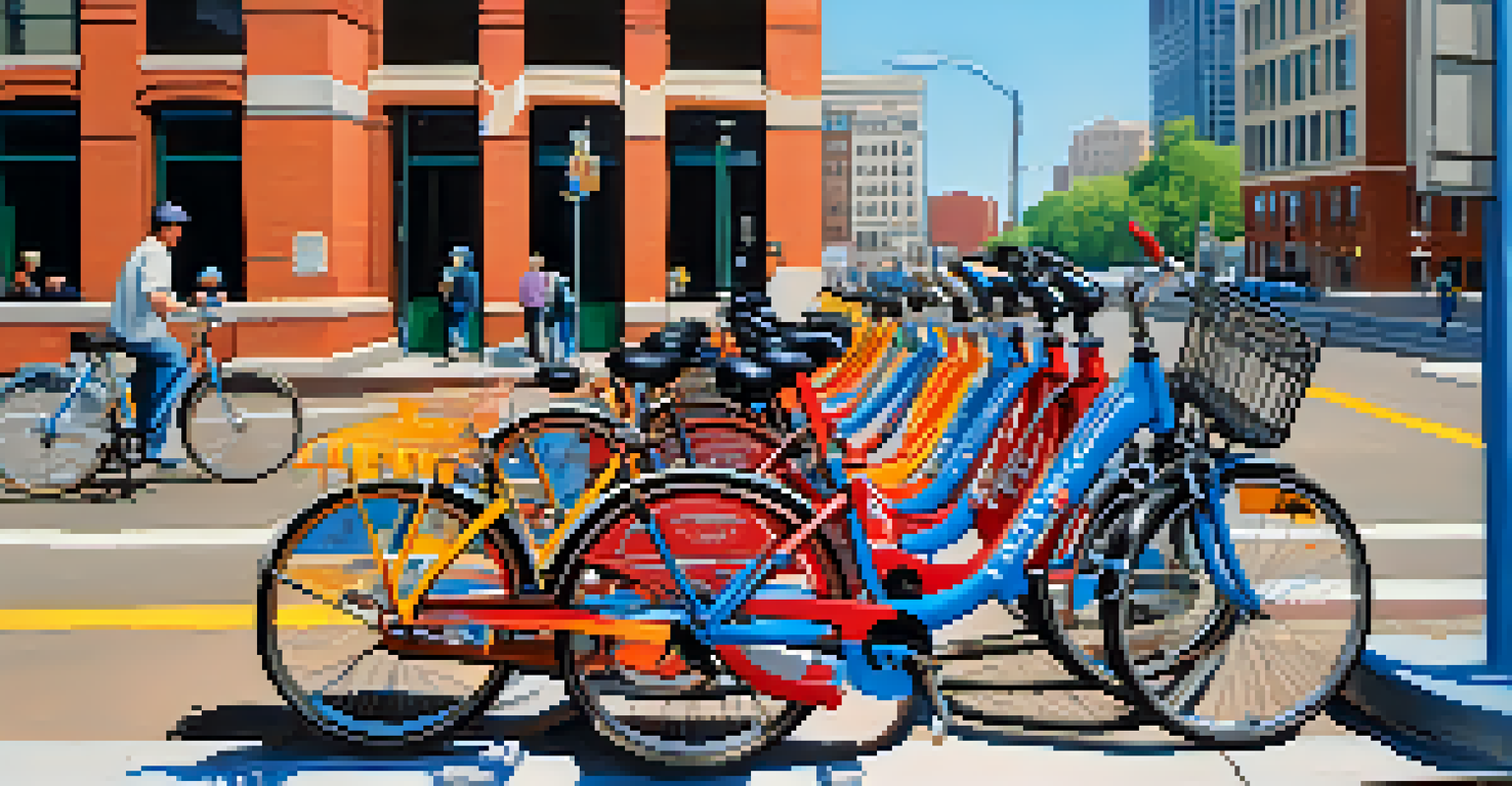The Role of Biking in St. Louis Transportation Systems

Biking as a Sustainable Transportation Option in St. Louis
Biking is rapidly emerging as a sustainable transportation option in St. Louis. With growing concerns about pollution and traffic congestion, many residents are turning to bicycles as a cleaner alternative. Not only does biking reduce carbon emissions, but it also alleviates some of the pressure on public transit systems. This shift toward cycling reflects a broader trend in urban areas, where sustainability is becoming a key priority for city planners.
Biking is not just a mode of transportation; it's a way to discover and connect with our communities.
As part of a multifaceted approach to transportation, biking helps create a more balanced mobility ecosystem. When integrated with public transport, biking can extend the reach of transit systems, allowing commuters to cover greater distances. For instance, a bike ride to a metro station can significantly cut down on travel time, making it easier for people to choose public transport over driving. This synergy enhances overall accessibility and convenience for St. Louisans.
Moreover, the city is investing in cycling infrastructure, making it safer and more appealing for residents. New bike lanes and bike-sharing programs are popping up across neighborhoods. These initiatives not only promote healthy lifestyles but also contribute to a vibrant community atmosphere, where more people are encouraged to explore their surroundings on two wheels.
The Health Benefits of Biking in Urban Areas
Biking isn't just good for the environment; it's also fantastic for personal health. Regular cycling can improve cardiovascular fitness, strengthen muscles, and enhance mental well-being. In a bustling urban setting like St. Louis, incorporating biking into daily routines can significantly increase physical activity levels. This is especially important in a time when sedentary lifestyles are prevalent.

Additionally, biking can be an effective way to reduce stress. The rhythmic motion of pedaling, combined with fresh air and the sights of the city, can create a calming experience. Imagine commuting through Forest Park, with its scenic views and abundant green space—it’s not just a way to get from point A to B; it’s a mini getaway from the hustle and bustle of daily life.
Biking Boosts Urban Sustainability
Biking is becoming a key sustainable transportation option in St. Louis, helping to reduce pollution and traffic congestion.
Local health organizations are recognizing these benefits and promoting biking as a way to combat chronic diseases. Campaigns that encourage residents to cycle instead of drive can lead to healthier communities. With St. Louis’s commitment to enhancing bike-friendly policies, the future looks bright for both individual health and community wellness.
Economic Advantages of a Biking-Friendly City
Biking can also provide significant economic benefits to St. Louis. By fostering a bike-friendly environment, the city can attract more visitors and residents who value accessibility and sustainability. Local businesses, from cafes to retail shops, often see increased foot traffic when biking infrastructure is improved. This can lead to higher sales and a more vibrant local economy.
Cycling is a sustainable solution that not only benefits our health but also strengthens the local economy.
Moreover, investing in biking infrastructure can lead to lower transportation costs for residents. When people choose to bike instead of drive, they save money on gas, parking, and vehicle maintenance. These savings can be redirected into the local economy, benefitting businesses and creating a more prosperous community overall.
Additionally, cities that prioritize biking often see an increase in property values. Homes in bike-friendly neighborhoods typically command higher prices, as more individuals and families seek out areas that promote active lifestyles. This trend not only enhances the quality of life for current residents but also contributes to the long-term economic vitality of St. Louis.
Challenges Facing Biking Infrastructure in St. Louis
Despite the many benefits, St. Louis faces several challenges in developing its biking infrastructure. One of the primary concerns is the lack of connectivity between existing bike lanes and major destinations. Cyclists often encounter gaps in the network, which can discourage potential riders from taking to the streets. Addressing these gaps is crucial for creating a cohesive biking experience.
Safety is another significant challenge that city planners must tackle. Many streets in St. Louis lack proper bike lanes or are designed primarily for motor vehicles, making it daunting for cyclists to navigate. This can lead to accidents and deter people from biking altogether. Community advocacy and city initiatives are essential to push for safer cycling conditions.
Health Benefits of Cycling
Regular biking enhances physical fitness and mental well-being, providing a refreshing escape amidst urban life.
Furthermore, public perception plays a role in the adoption of biking as a viable transportation option. Some residents may view biking as impractical or unsafe, especially in adverse weather conditions. Education and outreach efforts are needed to shift these perceptions and highlight the benefits of cycling, ultimately encouraging more people to embrace biking as a part of their daily lives.
The Role of Community Programs in Promoting Biking
Community programs play a pivotal role in promoting biking in St. Louis. Initiatives such as organized group rides, cycling workshops, and education campaigns can help foster a culture of biking. These programs not only provide opportunities for people to learn about cycling but also create a sense of community among cyclists. Events like 'Bike to Work Day' or local bike festivals can encourage individuals to explore biking as a fun and viable transportation option.
Non-profit organizations and local governments are collaborating to implement programs that address barriers to cycling. For example, providing free or low-cost bike repair services can help ensure that bicycles are maintained and safe to ride. Additionally, offering incentives for businesses to support biking initiatives can lead to a more bike-friendly work environment, attracting more employees who bike to work.
By engaging with the community, these programs can also help shape city policies around biking. Feedback from residents can guide planners in creating an infrastructure that meets the needs of cyclists. Ultimately, strong community involvement is key to fostering a biking culture that supports St. Louis’s growth and sustainability.
Integrating Biking with Public Transportation
Integrating biking with public transportation is a critical step toward enhancing St. Louis's overall mobility. By ensuring that bike racks are available on buses and at transit stations, the city can create a seamless transition between biking and public transport. This connectivity allows commuters to use bikes for the first and last mile of their journeys, making public transport more accessible and appealing.
Moreover, bike-sharing programs can serve as a convenient option for those who may not own a bicycle. With stations strategically placed near transit hubs, residents and visitors can easily grab a bike for short trips. This can be particularly beneficial for tourists who want to explore St. Louis without the hassle of renting a car.
Economic Gains from Biking
Investing in biking infrastructure can stimulate local economies by increasing foot traffic and reducing transportation costs.
Collaboration between city planners and transit authorities is essential to create a comprehensive transportation network. By promoting the idea that biking is a complementary mode of transport, St. Louis can reduce traffic congestion while enhancing mobility for all residents. This integrated approach sets the stage for a more sustainable future.
The Future of Biking in St. Louis
Looking ahead, the future of biking in St. Louis appears promising. With a growing emphasis on sustainable transportation, city officials are increasingly recognizing the importance of investing in biking infrastructure. Plans for expanding bike lanes, improving safety measures, and launching educational campaigns are already underway, signaling a commitment to making St. Louis a bike-friendly city.
As more residents embrace cycling as a primary mode of transport, we can expect to see a cultural shift toward healthier, more active lifestyles. This transformation could lead to a more engaged community, where residents are connected to their neighborhoods and each other through biking. The potential for increased community interactions and local events centered around biking is exciting.

Ultimately, the success of biking in St. Louis will depend on collaboration among residents, city planners, and advocacy groups. By working together, they can create a vibrant biking culture that not only enhances transportation options but also enriches the quality of life for all citizens. The road ahead is filled with opportunities, and biking could very well be at the forefront of St. Louis’s urban evolution.